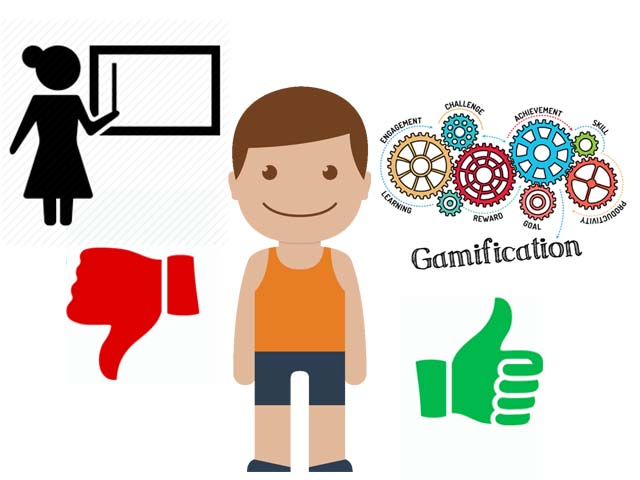
“There is an abundance of proof that lecturing is outmoded, outdated, and inefficient.”
Bid adieu to boring lectures and keep your students engaged and motivated through gamification
Boredom is one of the main reasons behind lack in performance as students get tired of having the same tasks every day
Have you ever wondered why children get so bored in school, yet are interested in playing with silly things?
A few things that children love to do are climbing trees, playing tic-tac-toe in class or running wild. Climbing trees teaches children to trust their own judgement, so it works as a fun activity as well as a learning experience.
If we pause for a moment and ask ourselves why kids like to do these things, we’d understand that they simply do them because they feel challenged. They test themselves, use their minds and get involved in activities which catch their interest. The same way, games have a pull that attract children and adults towards them.
“Good games are designed in such a way that the more we fail the more we want to succeed.” – André Klein.
Since games have evolved through decades, it’s time to learn how they can be applied in a classroom.
What is gamification?
Gabe Zichermann, a gamification expert and public speaker, defines gamification as the process of using game-thinking and game-mechanics to engage an audience into solving problems. It is basically the art of deriving all the fun and addictive elements found in games and applying them to real world activities. Gamification follows the same practices that game designers use to engage their players.
It is not about creating something new but using the same game-mechanics that make games so engaging and applying them to non-gaming areas to gain the attention that can help in adding value to course-related activities.
Why is it getting popular?
Gamification has become a bit of a buzzword in the last few years. There is an exact science behind why it is getting increasingly popular, which states that gamification creates a sense of excitement within the learners because they feel that they are accomplishing something substantial. This experience takes the learners to a whole new level.
How does gamification work?
Video games are amongst the most popular entertainment platforms in the world. Around three billion video games were sold worldwide from 2015-2016 and the industry continues to grow rapidly. The rise of mobile gaming has engaged more people, as from a three-year-old kid to a grandmother, everyone likes to play. For millions of kids, teenagers and adults, playing video games has become an obsession.
Gamification works by motivating students to engage in desired behaviours, by showing them a path to mastery and by taking advantage of their psychological nature to engage in these activities. In games, winning may be the ultimate reward, but it is equally important how someone gets there and they can only get there by learning and following the rules.
There are certain elements which are used in most games, such as challenge, chance, competition, cooperation, feedback, rewards, winning and progression. These elements can easily be extracted from the contents of a game and be implemented in any classroom. The core idea is to take the engaging elements of games and to implement them into the teaching process.
Challenges:
In this new age, keeping students fully engaged has become a challenge and it will continue to challenge the teachers. Eric Mazur, a physicist at Harvard University who has campaigned against old lecturing techniques for 27 years, said,
“There is an abundance of proof that lecturing is outmoded, outdated, and inefficient.”
In reality, students get tired of having the same schedule and tasks every day. They usually avoid going to class where they just have to write down notes despite hand cramps. They are sick of rote learning through the same old means. Boredom is one of the main reasons students’ performance drops in the classroom.
It is a fact that motivated learners learn more than the unmotivated ones. Effective learning only takes place when students are mentally, physically, and emotionally ready to learn.
In reality, no one likes a boring lecture and we should be doing our best to prevent our children from getting bored in the classroom. Essentially, boredom does lead to a lack in performance.
The main goal of classroom gamification is to keep students motivated by making the content more fun and enjoyable. There are reasons why students don’t perform well even after being provided with all the resources. At first, I used to blame everything on the students, thinking that they don’t have the skills or potential, but when I watched them playing games or doing things that interested them more, I realised that they are not as weak as I thought they were. It’s just that sometimes our classrooms are not providing them with the right tools to motivate them. Therefore, they lose interest, don’t understand the instructions or avoid playing an effective part in the classroom.
We either keep up with the requirements of this new age or lose to the attention. We need to look at what it is about games that make kids want to play more, why students prefer spending more time playing games instead of doing homework, and why our classrooms lack the energy that pushes students forward. These are some basic questions that schools and teachers need to ask themselves before planning for new sessions.
Hence, it is important for teachers to try out new techniques, because at the rate we are advancing, our students need to be constantly occupied and motivated. The same old textbook routine just cannot cut it anymore.
“It’s the teacher that makes the difference, not the classroom.” – Michael Morpurgo
This post originally appeared here.

COMMENTS (6)
Comments are moderated and generally will be posted if they are on-topic and not abusive.
For more information, please see our Comments FAQ